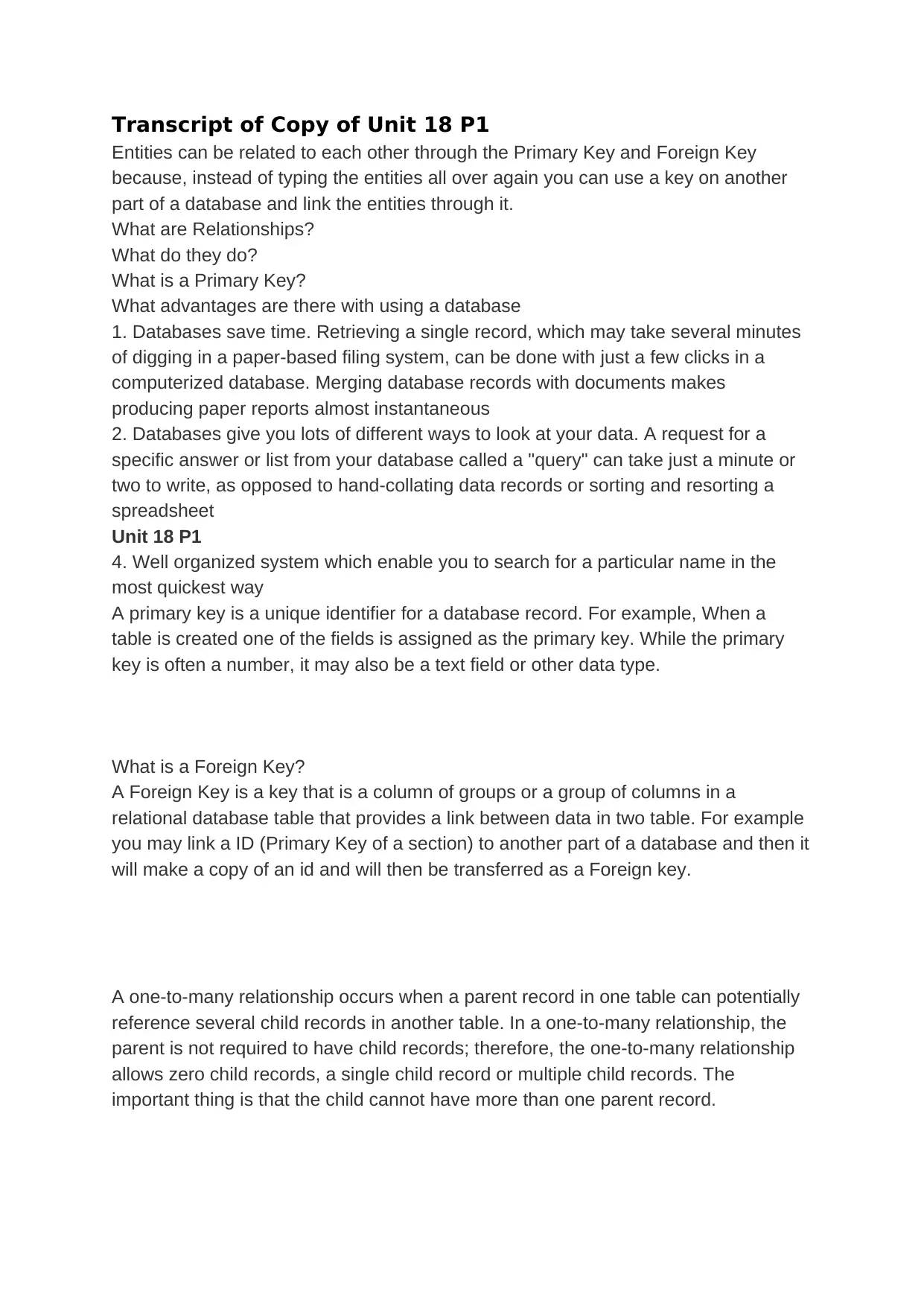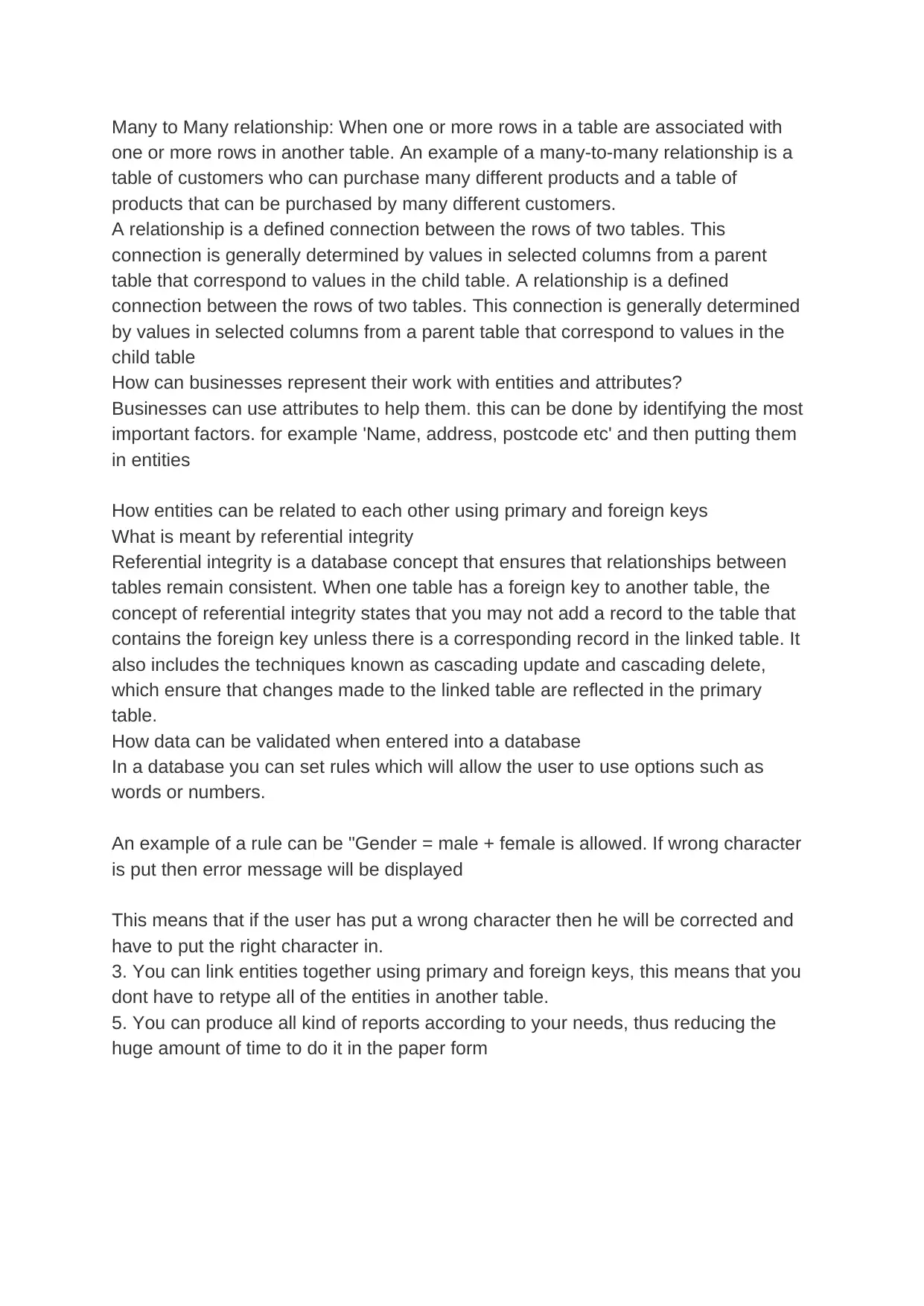Unit 18 P1: Understanding Database Relationships and Data Validation
VerifiedAdded on 2019/09/16
|2
|813
|269
Homework Assignment
AI Summary
This assignment transcript for Unit 18 P1 explores fundamental database concepts. It explains how entities are linked through primary and foreign keys, emphasizing the advantages of database systems, such as time-saving and flexible data views. The document defines primary and foreign keys, describes one-to-many and many-to-many relationships, and outlines how businesses can represent their work using entities and attributes. It also covers referential integrity and data validation techniques, including setting rules for data entry. The assignment highlights how these concepts ensure data consistency and accuracy, providing a comprehensive overview of database principles and practices.

Transcript of Copy of Unit 18 P1
Entities can be related to each other through the Primary Key and Foreign Key
because, instead of typing the entities all over again you can use a key on another
part of a database and link the entities through it.
What are Relationships?
What do they do?
What is a Primary Key?
What advantages are there with using a database
1. Databases save time. Retrieving a single record, which may take several minutes
of digging in a paper-based filing system, can be done with just a few clicks in a
computerized database. Merging database records with documents makes
producing paper reports almost instantaneous
2. Databases give you lots of different ways to look at your data. A request for a
specific answer or list from your database called a "query" can take just a minute or
two to write, as opposed to hand-collating data records or sorting and resorting a
spreadsheet
Unit 18 P1
4. Well organized system which enable you to search for a particular name in the
most quickest way
A primary key is a unique identifier for a database record. For example, When a
table is created one of the fields is assigned as the primary key. While the primary
key is often a number, it may also be a text field or other data type.
What is a Foreign Key?
A Foreign Key is a key that is a column of groups or a group of columns in a
relational database table that provides a link between data in two table. For example
you may link a ID (Primary Key of a section) to another part of a database and then it
will make a copy of an id and will then be transferred as a Foreign key.
A one-to-many relationship occurs when a parent record in one table can potentially
reference several child records in another table. In a one-to-many relationship, the
parent is not required to have child records; therefore, the one-to-many relationship
allows zero child records, a single child record or multiple child records. The
important thing is that the child cannot have more than one parent record.
Entities can be related to each other through the Primary Key and Foreign Key
because, instead of typing the entities all over again you can use a key on another
part of a database and link the entities through it.
What are Relationships?
What do they do?
What is a Primary Key?
What advantages are there with using a database
1. Databases save time. Retrieving a single record, which may take several minutes
of digging in a paper-based filing system, can be done with just a few clicks in a
computerized database. Merging database records with documents makes
producing paper reports almost instantaneous
2. Databases give you lots of different ways to look at your data. A request for a
specific answer or list from your database called a "query" can take just a minute or
two to write, as opposed to hand-collating data records or sorting and resorting a
spreadsheet
Unit 18 P1
4. Well organized system which enable you to search for a particular name in the
most quickest way
A primary key is a unique identifier for a database record. For example, When a
table is created one of the fields is assigned as the primary key. While the primary
key is often a number, it may also be a text field or other data type.
What is a Foreign Key?
A Foreign Key is a key that is a column of groups or a group of columns in a
relational database table that provides a link between data in two table. For example
you may link a ID (Primary Key of a section) to another part of a database and then it
will make a copy of an id and will then be transferred as a Foreign key.
A one-to-many relationship occurs when a parent record in one table can potentially
reference several child records in another table. In a one-to-many relationship, the
parent is not required to have child records; therefore, the one-to-many relationship
allows zero child records, a single child record or multiple child records. The
important thing is that the child cannot have more than one parent record.
Paraphrase This Document
Need a fresh take? Get an instant paraphrase of this document with our AI Paraphraser

Many to Many relationship: When one or more rows in a table are associated with
one or more rows in another table. An example of a many-to-many relationship is a
table of customers who can purchase many different products and a table of
products that can be purchased by many different customers.
A relationship is a defined connection between the rows of two tables. This
connection is generally determined by values in selected columns from a parent
table that correspond to values in the child table. A relationship is a defined
connection between the rows of two tables. This connection is generally determined
by values in selected columns from a parent table that correspond to values in the
child table
How can businesses represent their work with entities and attributes?
Businesses can use attributes to help them. this can be done by identifying the most
important factors. for example 'Name, address, postcode etc' and then putting them
in entities
How entities can be related to each other using primary and foreign keys
What is meant by referential integrity
Referential integrity is a database concept that ensures that relationships between
tables remain consistent. When one table has a foreign key to another table, the
concept of referential integrity states that you may not add a record to the table that
contains the foreign key unless there is a corresponding record in the linked table. It
also includes the techniques known as cascading update and cascading delete,
which ensure that changes made to the linked table are reflected in the primary
table.
How data can be validated when entered into a database
In a database you can set rules which will allow the user to use options such as
words or numbers.
An example of a rule can be "Gender = male + female is allowed. If wrong character
is put then error message will be displayed
This means that if the user has put a wrong character then he will be corrected and
have to put the right character in.
3. You can link entities together using primary and foreign keys, this means that you
dont have to retype all of the entities in another table.
5. You can produce all kind of reports according to your needs, thus reducing the
huge amount of time to do it in the paper form
one or more rows in another table. An example of a many-to-many relationship is a
table of customers who can purchase many different products and a table of
products that can be purchased by many different customers.
A relationship is a defined connection between the rows of two tables. This
connection is generally determined by values in selected columns from a parent
table that correspond to values in the child table. A relationship is a defined
connection between the rows of two tables. This connection is generally determined
by values in selected columns from a parent table that correspond to values in the
child table
How can businesses represent their work with entities and attributes?
Businesses can use attributes to help them. this can be done by identifying the most
important factors. for example 'Name, address, postcode etc' and then putting them
in entities
How entities can be related to each other using primary and foreign keys
What is meant by referential integrity
Referential integrity is a database concept that ensures that relationships between
tables remain consistent. When one table has a foreign key to another table, the
concept of referential integrity states that you may not add a record to the table that
contains the foreign key unless there is a corresponding record in the linked table. It
also includes the techniques known as cascading update and cascading delete,
which ensure that changes made to the linked table are reflected in the primary
table.
How data can be validated when entered into a database
In a database you can set rules which will allow the user to use options such as
words or numbers.
An example of a rule can be "Gender = male + female is allowed. If wrong character
is put then error message will be displayed
This means that if the user has put a wrong character then he will be corrected and
have to put the right character in.
3. You can link entities together using primary and foreign keys, this means that you
dont have to retype all of the entities in another table.
5. You can produce all kind of reports according to your needs, thus reducing the
huge amount of time to do it in the paper form
1 out of 2
Related Documents
Your All-in-One AI-Powered Toolkit for Academic Success.
+13062052269
info@desklib.com
Available 24*7 on WhatsApp / Email
![[object Object]](/_next/static/media/star-bottom.7253800d.svg)
Unlock your academic potential
Copyright © 2020–2025 A2Z Services. All Rights Reserved. Developed and managed by ZUCOL.





